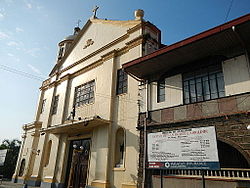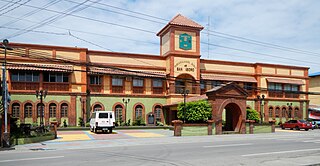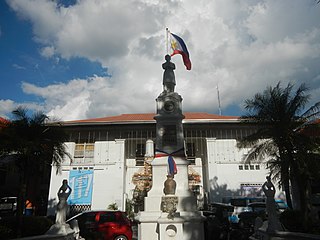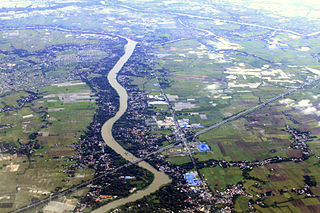| Pulilan | ||
|---|---|---|
| Municipality | ||
| Municipality of Pulilan Bayan Ng Pulilan | ||
Clockwise from top-left: Pulilan Municipal Hall, San Isidro Labrador Parish Church, kneeling carabaos, pahiyas | ||
| ||
| Nickname(s): Pulo ng Ilan The Center of Commerce and Industry in Northern Bulacan Home of the Kneeling Carabao Festival The Blessed Land | ||
| Motto(s): Celebrate Pulilan Power! | ||
| Anthem: Himno ng Pulilan Ako ang Pulileño | ||
 Map of Bulacan with Pulilan highlighted | ||
| Coordinates: 14°54′N120°51′E / 14.9°N 120.85°E Coordinates: 14°54′N120°51′E / 14.9°N 120.85°E | ||
| Country | ||
| Region | Central Luzon (Region III) | |
| Province | ||
| District | 1st District | |
| Founded | January 20, 1796 | |
| Barangays | 19 | |
| Government [1] [2] | ||
| • Type | Sangguniang Bayan | |
| • Mayor | Maritz Ochoa-Montejo (Liberal) | |
| • Vice Mayor | Ricardo Candido (PDP-Laban) | |
| • Electorate | 53,638 voters (2016) | |
| Area [3] | ||
| • Total | 39.89 km2 (15.40 sq mi) | |
| Highest elevation | 40 m (130 ft) | |
| Population (2015 census) [4] | ||
| • Total | 97,323 | |
| • Density | 2,400/km2 (6,300/sq mi) | |
| • Poverty rate | ||
| Demonym(s) | Pulileño, Pulileña | |
| Time zone | PST (UTC+8) | |
| ZIP code | 3005 | |
| IDD : area code | +63 (0)44 | |
| Income class | 1st class urban | |
| • Revenue (2017) | ||
| • Expenses (2017) | ||
| • Total Assets (2017) | ||
| Electricity | Manila Electric Company | |
| • Consumption | 63.65 million kWh (2003) | |
| Website | www | |
Pulilan, officially the Municipality of Pulilan (Tagalog : Bayan ng Pulilan; Kapampangan : Balen ning Pulilan), is a first class urban municipality in the province of Bulacan, Philippines. According to the 2015 census, it has a population of 97,323 people. [4] The town is famous for its Carabao Festival where carabaos are paraded and kneel as they pass through San Isidro Labrador Parish Church, in honor to the town's patron saint, San Isidro Labrador. [5]

Tagalog is an Austronesian language spoken as a first language by a quarter of the population of the Philippines and as a second language by the majority. Its standardized form, officially named Filipino, is the national language of the Philippines, and is one of two official languages alongside English.

Kapampangan, Pampango, or the Pampangan language is a major Philippine language. It is spoken in the province of Pampanga, most of Tarlac and Bataan. Kapampangan is also understood in some municipalities of Bulacan and Nueva Ecija and by the Aeta people of Zambales. The language is known honorifically as Amánung Sísuan.

The Philippines, officially the Republic of the Philippines, is an archipelagic country in Southeast Asia. Situated in the western Pacific Ocean, it consists of about 7,641 islands that are categorized broadly under three main geographical divisions from north to south: Luzon, Visayas, and Mindanao. The capital city of the Philippines is Manila and the most populous city is Quezon City, both part of Metro Manila. Bounded by the South China Sea on the west, the Philippine Sea on the east and the Celebes Sea on the southwest, the Philippines shares maritime borders with Taiwan to the north, Vietnam to the west, Palau to the east, and Malaysia and Indonesia to the south.
Contents
- Etymology
- History
- Geography
- Topography
- Land use
- Climate
- Barangays
- Demographics
- Ethnic groups
- Languages
- Literacy
- Religion
- Government
- Current officials
- Past officials
- Barangay officials
- Official seal
- Economy
- Agriculture
- Banking
- Car dealerships
- Industry and Trade
- Shopping malls
- Tourism
- Historical and religious edifices
- Mandalá Art Festival
- Infrastructure
- Transportation
- Road networks
- Utilities
- Social services
- Education
- Health
- Peace and Order
- Notable Pulileños
- Sister cities
- See also
- Gallery
- References
- External links
Many years ago, Pulilan was primarily a little-known rural town in the northern part of Bulacan where its economy heavily dependent on farming and poultry raising. Most of the population committed their entire lives on farming as their livelihood. Today, the town is moving towards commercialization and industrialization as it is becoming one of the major growth-rate area and center of commerce and industry in the province.

Poultry are domesticated birds kept by humans for their eggs, their meat or their feathers. These birds are most typically members of the superorder Galloanserae (fowl), especially the order Galliformes.
Because of the major economic growth, due to presence of commercial establishments, real estates, industrial plants and major road projects. Pulilan has experienced increased in the total gross income in the past few years. The town's income in year 2016 was P323.86 million, an increase of P69.27 million from its previous income in 2014. It surpass the income of fifteen municipalities in Bulacan such as San Miguel, Bocaue, Plaridel, Hagonoy and Calumpit.

Bulacan is a province in the Philippines, located in the Central Luzon Region in the island of Luzon, 11 kilometres (6.8 mi) north of Manila, and part of the Metro Luzon Urban Beltway Super Region. Bulacan was established on August 15, 1578.

San Miguel, officially the Municipality of San Miguel,, is a 1st class municipality in the province of Bulacan, Philippines. According to the 2015 census, it has a population of 153,882 people.
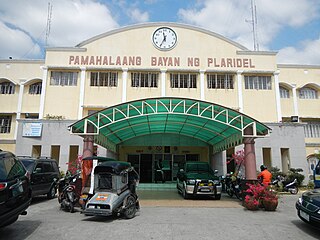
Plaridel, officially the Municipality of Plaridel,, is a 1st class municipality in the province of Bulacan, Philippines. According to the 2015 census, it has a population of 107,805 people.
With the continuous expansion of Metro Manila, the municipality is now included in Manila built up area which reaches San Ildefonso in its Northernmost part.

Metropolitan Manila, officially the National Capital Region (NCR), is the seat of government and one of the three defined metropolitan areas of the Philippines. It is composed of 16 cities namely: the City of Manila, Quezon City, Caloocan, Las Piñas, Makati, Malabon, Mandaluyong, Marikina, Muntinlupa, Navotas, Parañaque, Pasay, Pasig, San Juan, Taguig, and Valenzuela, as well as the municipality of Pateros.

San Ildefonso, officially the Municipality of San Ildefonso,, is a 1st class municipality in the province of Bulacan, Philippines. According to the 2015 census, it has a population of 104,471 people.

